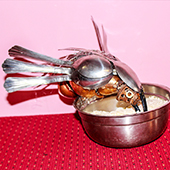Design Resource
Metal Spoon Bird - Ahmednagar, Maharashtra
Metallic Sculpture
by
Prof. Bibhudutta Baraland Srikanth B
Throughout the evolution of mankind, along with the sequential changes in life, their surroundings and culture also equally witnessed transformations, specifically shaped to suit human life. Each progress instigated something new into the lifestyles of human beings, like the introduction of utensils into the way we approached food and servings. In this list, spoons make a primary part of the food consumption, widely found in the areas of the west. Likewise, humans slowly started developing arts and crafts out of these utensils to exhibit their imagination, culture, and architect. Hence we still see an unending development in the area of art, which is still manifesting itself into new and improved forms. Here we are emphasizing metal spoon birds as a handicraft form which is still extensively in practice.
The word spoon is believed to be derived from the Greek word ‘Cochlea’ which means snail, signifying the use of snail shells as spoons in ancient Greece. Many old scriptures from Egypt, India, and China also hold mentions on the use of these curvy utensils. According to history, traces of spoons were first found in Europe in the year 1259. While forks are believed to be a contribution of the Qijia community (2400- 1900 BC) from present-day China. During the ancient days, materials like ivory, flint, slate, and wood were majorly used to make the spoons. Sporadically, illustrations from 11th century Rome under the Byzantine Empire carried images of people using forks to consume hard food items like meat, shells, and plant roots. And the current style of stainless steel spoons was introduced lately in 1970. While in the case of India, spoons and forks were very sparsely used, as eating with hands was very much a part of their culture. But in modern India, with the amalgamation of varied traditions, heightened inter-association, and global level cultural exchanges, the presence of spoons and fork in the eating table is a normal view in the country now.
Mr. Balaji Vallal from the district of Ahmednagar in Maharashtra is an Indian artist who specialized in sculpture making, especially one made of clay, metal spoons, metal scraps, and fiber casting. From his range of works, metal spoon birds and scrap metal are the most noted, which is a regular participant in all prominent art exhibitions across the country, where they are displayed as well as sold.




